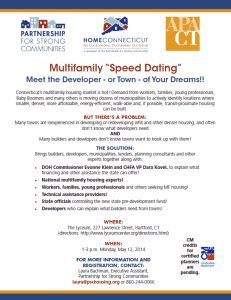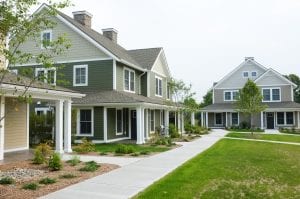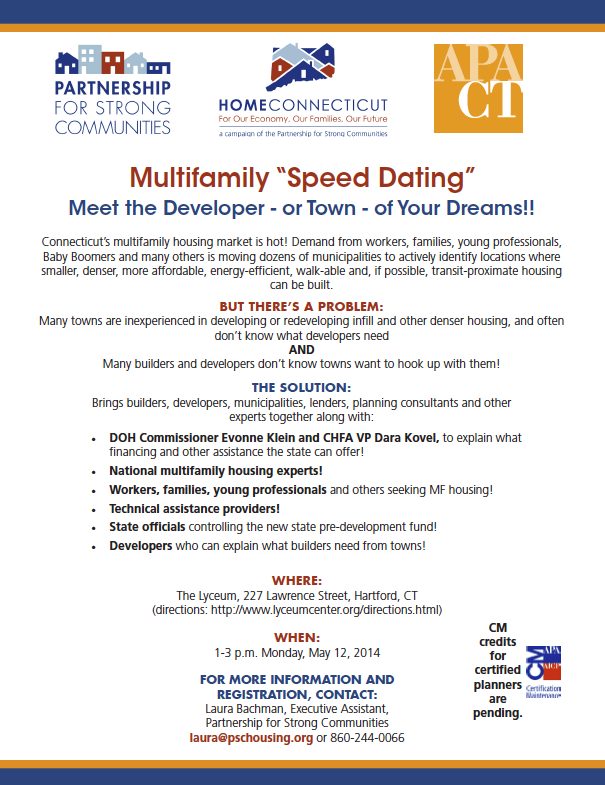
Connecticut is conducting an experiment: what happens when a state provides unique incentives to local municipalities willing to diversify their housing stock to include affordable options? What if the state actually pays local governments to engage in proactive, resident-driven local planning to identify areas suitable for higher density, multi-family housing not allowed by current zoning? Finally, what if the state rewards those towns that make changes by cutting them a check based on the numbers of units they actually allow to be built? The HOMEConnecticut program does just that.
Known officially as the Connecticut Housing Program for Economic Growth, HOMEConnecticut was launched by the state legislature in 2007. Run by the state’s Department of Housing, the program provides incentives for local municipalities to voluntarily create Incentive Housing Zone overlays to their existing zoning to allow more as-of-right higher-density, affordable housing development and/or streamlined permitting within the designated zones.
How the Incentive Housing Zone Works

Ferry Crossing in Old Saybrook. The project consists of 16 affordable rental units, ranging from 25-80 percent of area median income. There are 1-, 2-, and 3-bedroom units. The project is located on a bus route, adjacent to a recreational field and situated within an existing residential neighborhood. Photo courtesy of the Women’s Institute for Housing and Economic Development
Before an Incentive Housing Zone is created, localities can be granted up to $20,000 for costs relating to general planning, such as identifying potential sites, drafting regulations and design guidelines, and completing infrastructure and small engineering studies. Up to another $50,000 can be granted toward pre-development costs relating to a specific project, and can be passed through to the developer. To qualify for additional state incentives, localities must create an Incentive Housing Zone which meets state standards on unit density per acre by building type (6 single-family, 10 duplex/townhouse, or 20 multifamily units), affordability (at least 20 percent of units affordable to households earning at or below 80 percent of area median income), and location (near downtown, transit, and/or existing or planned infrastructure). (There are some exceptions for public and nonprofit owners, and rural or lightly populated areas.) When a local government adopts an Incentive Housing Zone, it currently receives a $20,000 grant from the Department of Housing. Finally, once units are actually approved and built within the zone, municipalities receive an additional grant of between $15,000-50,000 based on the total number of units constructed, both market-rate and affordable, either multifamily or single-family. Higher incentive payments are currently being studied.
This use of IHZs is not an entirely new approach. Massachusetts’ Chapter 40R program, authorized by the Smart Growth Zoning Overlay District Act of 2004, also promotes incentive-based zoning. The act also encourages local governments to create IHZs for higher-density, affordable housing, particularly near transit stations and other “highly suitable locations” of already concentrated development, such as existing downtowns. Over 30 developments have been approved and completed through this legislation to date.
[RELATED ARTICLE: What Is NIMBYism and How Do Affordable Housing Developers Respond to It?]
The promotion of inclusionary zoning is not new, in and of itself, but using an incentive-based system is a different approach than older, more contentious and litigious legislation in Connecticut, Massachusetts, and several other states that suggest municipalities need a certain percentage of their housing stock to be affordable. In Connecticut, Section 8-30G of the state’s Affordable Housing Land Use Appeals Act (Chapter 126a) of 1990 states that municipalities should ensure that 10% of their housing stock is affordable to lower-income households, or else face potential state override of local zoning, if developers challenge denied applications to construct more affordable units. This is similar to the well-known Chapter 40B program in Massachusetts.
Instead of requiring that a jurisdiction adopt a blanket inclusionary zoning ordinance applicable to all projects of a certain size, regardless of location, Incentive Housing Zones are overlay districts that specifically target places where municipalities think that a higher density of mixed-income and multi-family development makes the most sense. By targeting areas within town to allow higher-density residential development as-of-right, town fears of being bullied by developers to build units in inappropriate locations are assuaged, and developers save time and resources by skipping the point in the development process where community opposition most frequently stymies projects: the local approval process for zoning variances and special permits.
The Partnership for Strong Communities leads the HOMEConnecticut campaign to educate municipalities about the benefits and incentives of creating Incentive Housing Zone. At a statewide meeting on March 31st, PSC hosted an expert on Massachusetts’ 40R Incentive Housing Zone program, Angus Jennings, AICP. Speaking to an audience of over 100 town representatives, planners, developers, and architects, Jennings emphasized the foundational importance of housing in developing any plans for the future. He noted that the intent of the 40R program in Massachusetts and the 8-30G program in Connecticut is to shift communities from a reactionary position against any new housing development, toward a more proactive and strategic approach to recognizing changing demographic needs and asking where necessary housing development could best be accommodated within the town.
Jennings suggested how these programs offer opportunities for local flexibility and intentionality in allowing more as-of-right higher-density, affordable housing in ways that meet specific local needs. First, he stressed the importance of broad community participation in identifying sites, developing the zones, and approving the zones through reaching consensus. In some Massachusetts’ towns, an Incentive Housing Zone must be approved via vote by two-thirds of residents at a town meeting. Second, he emphasized local control and customization of the process and outcomes. Each municipality must operate within realistic constraints on developable land and infrastructure when identifying appropriate sites. Finally, each community has control over establishing design guidelines to ensure that new developments within Incentive Housing Zones fit within the context of the local built environment. This includes repurposing existing buildings as well as developing new ones.
A panel of town representatives from five Connecticut municipalities helped drive home these points by sharing their experiences with the HOMEConnecticut model and process to date. Moderated by Dara Kovel, the Vice President of Multifamily Housing for the Connecticut Housing Finance Authority, these examples highlighted how the program could be used to educate constituencies and proactively plan for the future. Take the Town of Old Saybrook, for instance. For a waterfront municipality with no sewer system, the town had legitimate concerns about accommodating higher density development within their infrastructure limitations. Through a process of negotiation with the community and the state, more appropriate densities emerged within an IHZ that were in character with the community, created a reasonable buffer between a new development and an existing cemetery, and still allowed over 100 new units of affordable housing to be built. Or there is the Town of Colchester, where multi-family zoning had been limited to 4 units per acre and there was no talk of development. The Incentive Housing Zone process encourage discussion of demographic trends in this small community—including the decline of people ages 25-34 living in the town and the limited housing available for those age 55 and over—leading to proactive changes in zoning to allow for more housing units to accommodate these populations. This included increasing as-of-right density to 10 units per acre, and approving a development of live/work units, and another project containing accessory units for extended families. And all town representatives emphasized the importance of local choice over Incentive Housing Zone locations and design standards as major incentives to participate.
Selling the Need for Affordable Homes
The program seems to be making progress. Fifty applications for funding have been approved by the state, eight Incentive Housing Zones have been successfully created so far, and a handful of development projects have been completed or are underway. However, there are some lingering concerns expressed by policymakers, towns, and developers. For those promoting IHZs, there is still the need to prove that there is a shortage of necessary units in communities across the state. It can be an uphill battle to convince communities of single-family homeowners to think more broadly about their past and future needs for multi-family units, and beyond their current housing circumstances. Due to past litigation and threats, trust and cooperation is hard to establish between towns and developers. Towns continue to wrestle with water and sewer infrastructure issues, school enrollment concerns, and fears—of poor design, overdevelopment, and property rights violations. Other state processes required to get development projects in Incentive Housing Zones moving – such as environmental review—can slow things down even when both town and developer are eager to move forward.
While it is still too early to know the final outcome of this experiment, there is good reason to pay close attention. It just might be that Connecticut is crafting an effective strategy for turning NIMBY into YIMBY in communities where you would least expect it.
For more information on the HOMEConnecticut program, contact David Fink, policy director at the Partnership for Strong Communities. To register for the May 12 speed-dating event in Hartford, contact Laura Bachman.






Great article about incentivizing affordable housing. Folks interested in State incentive programs should look to California. The State Department of Housing and Communty Development has adopted numerous programs to incentivize local governments to plan for and approve affordable housing. State planning law (Housing Element), requires all communities to plan for the housing needs of all economic segments of the community as well as expected growth. To incentivize local governments to promote and approve affordable housing, several programs were adopted (although most do not currently have funding at this time). First, the Downtown Rebound Program provided planning grants for local governments to develop land inventories of infill sites and to update zoning requirements to support affordable housing development (increase densities, reduce development standards, etc.). Several other programs, the Jobs/Housing Balance Improvement Program and the Workforce Housing Program provided grant dollars based on the number of affordable housing units permitted (with additional dollars allocated based on location, affordability, etc.). Local governments were rewarded with grant dollars they could use for any local capital facility need when the adopted a housing element in compliance with state law and permitted affordable housing. The programs were a great success, but as the State went through numerous economic downturns, the funding for the programs were not continued. The current incentive program, Housing Related Parks, is modeled after the Workforce Housing Program but provides funding to create or rehabilitate parks as a reward for approving affordable housing. Not much money remains in the program. But all of these programs helped combat NIMBYs because affordable housing developers could argue by approving their housing the community would have new resources for critical needs including parks.
These programs should be funded and continued in California and elsewhere!
Another program for affordable housing and job creation awaits implementation in Connecticut. This program became law in 2013 when the Governor Malloy signed House Bill 6706. This law allows some communities to shift taxes off of privately-created building values and onto publicly-created land values.
A lower tax on building values makes buildings cheaper to construct, improve and maintain. This results in cheaper building rents that are beneficial to residents and businesses alike.
Surprisingly, the higher tax on land values helps keep land prices more affordable as well. This is because the supply of land is fixed and does not shrink as a result of taxation (unlike the supply of goods and services that are produced). Additionally, the higher tax on land values reduces the profits from land speculation, reducing the speculative demand for land and thereby putting downward pressure on land prices.
Thus, at no cost to a community, buildings and land can be made more affordable. This promotes affordable housing and job creation. The city of New London is one of the cities that has been granted authority to implement this type of tax reform.
For more information about this concept, see “Using Value Capture to Finance Infrastructure and Encourage Compact Development” at https://www.mwcog.org/uploads/committee-documents/k15fVl1f20080424150651.pdf